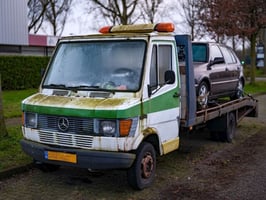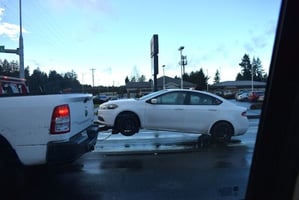Planning a trailer road trip is exciting—but it also comes with responsibility.
Skipping trailer prep can turn even the best-planned vacation into a roadside nightmare. A little effort now can save hours of trouble later.
Whether you're heading into the mountains, across state lines, or just down the coast, getting your trailer ready ensures smoother towing, fewer surprises, and a safer experience for everyone. From brake checks to weight balance and emergency gear, every step you take before departure adds confidence on the road.
If you want an even smoother ride, many experienced travelers rely on the ProPride 3P® Hitch, which uses sway-eliminating technology for unmatched towing control—even on long trips and rough terrain.
In this blog, we’ll cover:
- What to inspect and fix before hitting the road
- How to load and balance your trailer the right way
- What safety gear and trip planning tips to prioritize
Conducting a Thorough Trailer Inspection
No matter how new or old your trailer is, a full inspection is non-negotiable. It’s the first step toward avoiding unexpected breakdowns, dangerous handling, or costly delays.
What to Check Before Every Trip
Start with the most overlooked part—your tires. Inspect the tread depth, sidewalls, and make sure they're inflated to the recommended PSI. Don’t forget to check the spare tire, too.
Next, test all exterior lights:
- Brake lights
- Turn signals
- Running lights
- Reverse lights (if equipped)
Any malfunction here compromises road safety. Replace burned-out bulbs and clean dirty lenses.
Inspect your brakes, especially if your trailer is heavy. Confirm that:
- Electric brakes respond to your brake controller
- Brake fluid levels are full (if hydraulic)
- The breakaway cable activates the system when pulled
Check the hitch and coupler:
- Make sure the coupler latches securely to the ball
- Lubricate the hitch ball to prevent metal-on-metal friction
- Cross the safety chains below the tongue
- Confirm the PIN or lock is in place
These steps take minutes, but prevent miles of regret.
Ensuring Proper Weight Distribution and Balance
Weight distribution isn’t just about loading everything and hitting the road. It's about keeping the trailer balanced, centered, and stable to protect your equipment and ensure driver control.
Load Placement Matters
The ideal layout looks like this:
- 60% of total cargo weight placed in front of the axle
- 40% behind, but evenly distributed
- Keep heavier items low and centered
- Avoid stacking too much weight on one side
Getting the Tongue Weight Right
Tongue weight should equal 10–15% of the total trailer weight.
Too light? The trailer might sway.
Too heavy? Your vehicle's rear end can sag, lifting the front tires off the ground and reducing steering control.
Use a tongue weight scale or even a bathroom scale with a makeshift setup to measure. Adjust load placement until you're within range.
Don’t Forget to Secure Everything
Unsecured cargo can:
- Shift during travel, throwing off balance
- Damage the trailer or items inside
- Create unexpected noises or sudden handling issues
Use ratchet straps, nets, or cargo bars to keep everything tightly in place.
Securing Essential Safety Equipment
If you run into trouble on the road, being prepared can make the difference between a quick fix and a call for help. Here’s what every trailer owner should carry.
Basic Tool Kit
Pack tools specific to trailer maintenance:
- Wrenches and sockets
- Screwdrivers
- Pliers and cutters
- Tire pressure gauge
- Trailer lug wrench
- Grease gun (for suspension and hitch lube)
Emergency Essentials
You should never tow without:
- Spare tire and tire-changing tools
- Tire repair kit or plug kit
- First aid kit
- Fire extinguisher (Class B-C)
- Reflective triangles or LED road flares
Keep these stored where they’re easily accessible—not buried under luggage or equipment.
Spare Electrical and Mechanical Parts
Long trip ahead? Carry:
- Spare trailer light bulbs
- Fuses for the brake controller and lights
- Extra hitch pin and clip
- Zip ties and duct tape (temporary fixes in a pinch)
Being equipped for emergencies not only provides peace of mind but also helps you avoid being stranded in remote areas.
Planning and Preparing for the Journey Ahead
Towing safely also means preparing beyond the trailer itself. The more you know about your route, your stops, and your potential obstacles, the more confidently you’ll drive.
Map Out Your Route
Use both GPS and traditional maps to:
- Identify gas stations and rest stops
- Avoid low-clearance bridges or steep grades
- Plan stops every 2–3 hours to check tires, straps, and coupler
- Identify overnight parking options that allow trailers
Consider calling ahead at RV parks or fuel stations to confirm space for your setup.
Monitor the Weather
Rain, snow, wind, or extreme heat can affect:
- Towing traction
- Braking ability
- Visibility
- Road closures or delays
Use weather apps, DOT websites, or CB radio updates. Always have a Plan B route in case road conditions change.
Pack Smart
In addition to personal items, bring:
- Water and non-perishable snacks
- Power banks or backup batteries
- A printed version of your checklist
- Towing documentation (registration, insurance, service history)
- A copy of emergency contact numbers
Pro tip: Make a pre-trip checklist and physically mark off each item before departure.
Using the Right Hitch System for the Journey
Even if you’ve done everything right—balanced the load, secured the gear, inspected all systems—trailer sway can still happen due to wind, large passing vehicles, or uneven roads.
That’s where a sway-eliminating hitch comes in.
The ProPride 3P® Hitch is designed to eliminate sway before it starts. Its Pivot Point Projection™ technology moves the pivot point from the hitch ball to the rear axle of the tow vehicle, making your setup feel as stable as a fifth-wheel.
For long-haul trips, unpredictable weather, or first-time towers, this upgrade makes a huge difference in safety, confidence, and peace of mind.
Wrapping It Up
Preparing your trailer for a road trip is about more than checking boxes—it’s about setting yourself up for a smoother, safer, and more enjoyable journey. From inspecting brakes and lights to balancing your load and packing emergency gear, every step plays a role in keeping your trailer secure and your trip stress-free.
Confident towing begins with smart preparation. And if you want an extra layer of stability on the road, the ProPride Hitch offers unmatched sway control—perfect for long-distance travelers or anyone towing with caution.
The more prepared you are, the more you can focus on what matters: enjoying the road ahead.
Frequently Asked Questions
Even well-prepped travelers often overlook a few key things. These FAQs can help ensure you’re fully ready before your trailer hits the road.
1. How far in advance should I prep my trailer before a trip?
Ideally, start your inspection and load balancing at least 2–3 days before your departure. This gives you time to fix any issues, get parts if needed, and test your setup with a short local drive.
2. What’s the best way to test my trailer brakes before a trip?
Hook up your trailer and perform a low-speed brake test in an empty parking lot. Activate the trailer brake controller manually to see if the trailer responds evenly. Adjust the gain setting as needed.
3. How do I know if my trailer load is properly balanced?
After loading, check that the trailer rides level and that the tongue weight is within 10–15% of the total loaded weight. Uneven trailer handling, swaying, or nose-diving can signal poor weight distribution.
4. Do I need to grease the hitch ball every time I tow?
Yes. Apply a thin layer of hitch grease before every trip. It prevents metal-on-metal wear and helps the coupler rotate smoothly while turning. Wipe clean and reapply as needed.
5. Can I use regular roadside assistance for a trailer breakdown?
Not always. Many standard policies don’t cover trailers. Check with your provider or opt for specialized trailer or RV roadside coverage that includes towing, tire repair, and emergency support for your specific rig.


